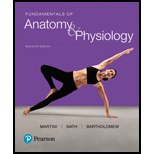
Introduction:
The neurons are present in the brain and they transmit the signal across the synaptic junctions in the brain by creating a membrane potential. The neurons consist of the two parts, the cyton and the axon. The cyton is the cell body containing the nucleus and the other organelles like mitochondria, endoplasmic reticulum, ribosomes, and the nucleus. The axons transmit impulses in the neurons. The axons have long projections in the form of dendrites, which transmit the signal waves across the neuronal junctions.The impulses are transmitted by the movement of the ions in the voltage gated channels present in the membrane.
Want to see the full answer?
Check out a sample textbook solution
Chapter 12 Solutions
Fundamentals of Anatomy & Physiology, Custom edition for Houston Community College Northwest, Volume 1, Includes student access code card
- What is Neurospora ?arrow_forwardDistinguish between the myelination process carried out by neurolemmocytes in the PNS and by oligodendrocytes in the CNS.arrow_forwardAccording to the function ofthe transmitted neuralimpulse which are the types ofneurons? How different arethe concepts of afference andefference of the neuralimpulse transmission?arrow_forward
 Human Biology (MindTap Course List)BiologyISBN:9781305112100Author:Cecie Starr, Beverly McMillanPublisher:Cengage Learning
Human Biology (MindTap Course List)BiologyISBN:9781305112100Author:Cecie Starr, Beverly McMillanPublisher:Cengage Learning
